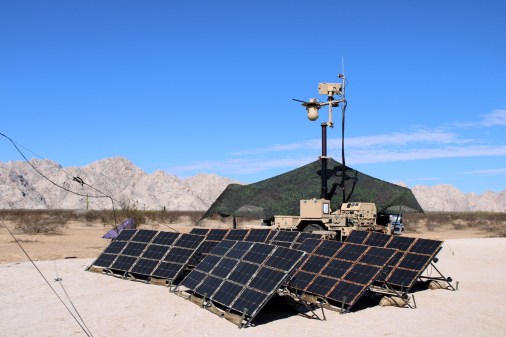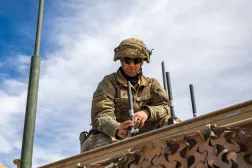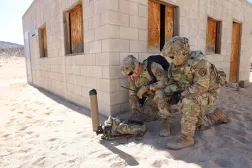Next iteration of Army’s ‘transforming-in-contact’ will focus on autonomy

This is part three of a three-part series examining the conclusion of the Army’s transforming-in-contact 1.0 initiative and looking forward to the next iteration. Part one can be found here and part two can be found here.
The next stage of the Army’s experimental effort to inform how it procures equipment and organizes formations will focus more on robotics and autonomy.
Transforming-in-contact, as the initiative is known, is a top priority for Army and Chief of Staff Gen. Randy George that aims to change the way the service buys, trains and employs technology, focusing on commercial-off-the-shelf gear.
For iteration 1.0, 3rd Brigade, 10th Mountain Division was the last of three light infantry brigades to test the gear during various combat training center rotations — the most realistic combat scenarios the Army can create for units to train — in the swamps of Louisiana, the dense foliage archipelagos of Hawaii and frigid European climates.
Transforming-in-contact 2.0 was announced last October but few details were provided regarding what specific units would be involved, just that it would scale up to divisions and expand to Stryker and armored brigades. When it comes to tech, officials explained that it would likely begin to focus more on autonomy.
“As we were looking at the drones, what we realized with both 2nd Brigade, 101st and 2nd Brigade, 25th ID was we need to get away from a one-to-one from operator to machine,” Alex Miller, the chief technology officer for the chief of staff of the Army, told reporters this week. “With the engineers, it’s not just replacing breaching vehicles, it’s how do you displace the capability and maybe use machines to do it. It’s flexibility on those types of things as well.”
Others noted that with armored units being brought into the fold, robotics will likely be a bigger focus.
“As you get an armor brigade combat team involved, there’s potential maybe to interject a little bit more on the robotics piece. The ground platforms, more than just the [Squad Multipurpose Equipment Transport] and things that you see right now with the light infantry brigade using. I think you might see some of that,” Lt. Gen. Charles Costanza, commander of V Corps, said in an interview. Then “the ground-launched effects capabilities on a platform that we’re trying to see if we can incorporate into both formations.”
Some things will be different with new units and echelons, but the overall concept will remain.
“It won’t be exactly the same, but it will be the same kind of bottom-up feedback that will inform us what kind of systems they need, what kind of problems they’re solving,” George said.
Officials have named 25th Infantry Division and 101st Airborne Division as the two divisions focused on transforming-in-contact 2.0 along with 2nd Cavalry Regiment — a Stryker unit, which is based in Europe — and 1st Brigade, 3rd Infantry Division as one of the two armored brigades and National Guard units.
Given 2CR’s location, officials explained they have some ideas already of how to incorporate lessons from Ukraine’s war with Russia to the transforming-in-contact concept.
At the division level, some of the experimentation will take place through joint warfighting assessments and warfighter exercises, command post-related events and simulations.
As the Army expands transforming-in-contact, it wants to look at a variety of echelons and all warfighting functions, George said, such as aviation and logistics.
“We know that logistics is going to have to be more dispersed. What do we have to do to make adjustments to that? What level of technology needs to be infused in our logistics formation is another example, so that they can protect or detect and do the things that they need to do with drones,” he said. “How are we going to do 3D printing through that at echelon, and not just at the brigade level, but that we can support that, because now you have a sustainment brigade? How does all of this interact with an aviation brigade and how do you do airspace control and how does that work together?”
Lessons from the first iteration will factor into what’s next and how the Army could alter its formations going forward.
“We’re taking all of these lessons and we are in the process right now of a force design update to decide, how [are] these formations … going to look, what do we need to do differently with that. We’ll come out with that and that will be how we’re deciding our organization,” George told reporters this week.
He explained that with the first three brigades having done their combat training center rotations, this is not the end point. The Army is taking the feedback and will continue to make modifications.
With heavier units comes platform integration and larger footprints.
Costanza said the Army will look to how the lighter units in 1.0 took drones and fires to organize into strike or multifunction reconnaissance companies, which were equipped with drones, loitering munitions, mortars and other equipment to shorten the sensor-to-shooter chain to degrade enemy formations sooner before they come in range of more traditional friendly units.
“It’s how you take the UAS, counter-UAS capabilities with the [electronic warfare] capabilities, again, little bit bigger, because now you got platform-mounted capabilities, not just [Infantry Squad Vehicles], but tanks, Bradleys, Strykers. I think that gives you a little bit more capability,” he said. “The other thing, too, is scope and scale. Light infantry brigades, especially when you talk about command posts, they already start out pretty small. [The Integrated Tactical Network] is giving them the ability to spread out even more and be even more disaggregated.”
While network technology allowed the lighter units to disperse more and lower their signatures, their command posts were already much smaller than heavier units. But, Costanza said, 2nd Cavalry Regiment has already been fielded much of those systems and had time to take advantage of them and learn how to disperse and reduce their signature.
The unit is also taking lessons from the strike companies that were just tested with 3rd Brigade, 10th Mountain in Europe.
“2nd Cavalry Regiment is watching this intently because their whole purpose in life was reconnaissance security, expanding the reaction time and maneuver space for the corps. Under future Army construct, we know that 2nd Cavalry is going to have to condense. Their ability to do this kind of shaping operation with a well-enabled strike company that 3/10 is experimenting with, again, will inform how they shape their redesign going forward with future technology and reachback enablers to the theater-level enablers,” Col. Aaron Dixon, deputy chief of staff for operations, plans and training, G3, at V Corps, said in an interview. “Being able to see some of those lessons learned from this rotation at the end will help shape TiC 2.0 that we have lined up with 2nd Cavalry.”
Larger echelons are also looking at the lessons from 1.0 and determining what that means for force design changes, new formations and how to fight.
“It’s been fascinating because the way we’re building these transformation-in-contact formation, starting with the infantry and then moving on to the other brigade combat teams, we’re getting a large set of data from multiple soldiers, multiple units and that’s immediately going to feed into that force design update,” Lt. Col. Donald Hackett, chief of force management at V Corps, said in an interview. “It’s all being fed from the soldier up. And then as the brigade combat teams built, we’re going to adjust … how the corps operate, how the divisions operate. And you’re going to see a transformation-in-contact 2.0 where they start building that out to the divisions. They’re doing experimentations with the corps. It’s just a whole new approach to how we get after designing units.”
The Army is trying to determine how some of the new technologies and equipment, which make brigades more effective at longer ranges, affects the overall battlefield geometry, to include for higher echelon units.
While the brigade was the primary unit of action during the Global War on Terror, the Army is moving that up to division in anticipation of potential large-scale combat operations against sophisticated adversaries such as Russia and China.
“As we see these capabilities at the brigade level and just the increased range that you have for both the kinetic and non-kinetic effects, but the sensors, and now you add that to the division level and then potentially, down the road, we’re not talking corps is part of TiC, but how does that change fundamentally maybe the way you think about and fight at echelon,” Costanza said. “These brigades have capability that can actually affect the division deep area and vice versa. The divisions are going to have capabilities that potentially can affect the corps deep area. Then let’s just talk about airspace management and everything else [that] is going on. It’s a fundamental shift, I think, in the way we got to think about the battlefield framework and how we fight at echelon.”
Others explained how these new capabilities that enabled the strike companies affect how corps thinks about fighting.
“It’s shaping how the corps is trying to gather information from how this brigade sees themselves operating to how that might change how the division sees its battlefield geometry and structure on how they fight for information,” Dixon said. “Then all the way up at the corps level, if I have a fully enabled brigade causing a more-enabled division, how does that change how the corps sees its shaping fight versus its close fight in the future? If you add that early reconnaissance capability proliferated all the way down to the lowest level and say I’m also increasing their reach with things like one-way drones, … how does that change how the corps sees the full battlefield geometry?”






